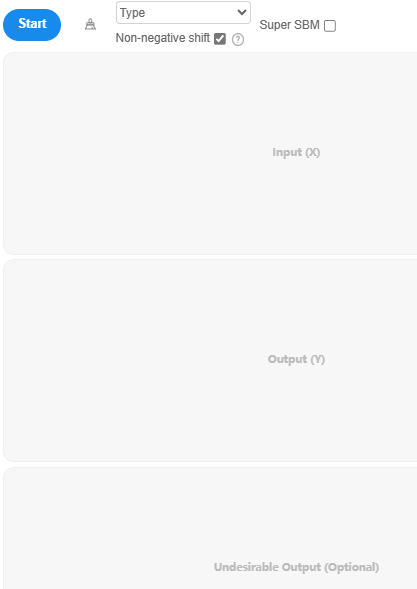Slack Based Measure (SBM)
Slacks Based Measure (SBM) is a non-parametric method used to evaluate the relative efficiency of Decision-making Units (DMUs), primarily in scenarios involving multiple inputs and multiple outputs. It is located in SPSSAU -> Comprehensive Evaluation -> Slacks Based Measure (SBM).
SPSSAU Operations

To conduct the analysis, drag the analysis items, including input items (X), output items (Y), and undesirable outputs, as well as DMUs, into the right-hand box and click 'Start'. SPSSAU includes three parameters: Type, Super SBM, and Non-negative Shift.
Type: The default is BCC (VRS, Variable Returns to Scale), but CCR (CRS, Constant Returns to Scale) is also available.
Super SBM: This option is not selected by default.
Non-negative Shift: When selected, if any column contains values ≤ 0, the shift unit is adjusted to the absolute value of the minimum value plus 0.01. This ensures all data are positive for proper calculation.
SPSSAU Data Format

To run an SBM or Super SBM, place DMUs in a separate column, while the other columns contain research indicators, including input indicators, output indicators, or undesirable output indicators. The DMU column is optional but can be placed in the 'DMU Label [Optional]' box if included.
Algorithm
1.Define Decision-making Units (DMUs)
First, identify the input and output variable data. Input variables represent resources used in the production process (e.g., labor, capital), while output variables represent the produced goods or services (e.g., product quantity, service quality). If the study includes 'undesirable output', it must also be provided.
2.Establish the SBM Model
SPSSAU supports four types of SBM models: SBM with BCC, SBM with CCR, Super-SBM with BCC, and Super-SBM with CCR:
SBM with BCC/CCR:
Assume x ∈ Rq,yg ∈ Ru1,yb ∈ Ru2, and define matrixi X、Yg、Yb:
X = [x1,...,xn] ∈ Rq×n > 0
Construct the production possibility set P:
Then, formulate the following mathematical model:
x,yg,yb: input, desirable output, undesirable output.
s-,sg,sb: slack vectors for input, desirable output, and undesirable output
λ: weight vector
The subscript "0" represents the evaluated unit.
The objective function ρ represents the efficiency value.
When ρ=1,s-,sg,sb, the DMU is efficient. If ρ < 1, efficiency loss exists, indicating the need for improvements in input and output.
The SBM model can be set to input-oriented, output-oriented, or non-oriented types:
Input-oriented: Minimizes inputs while maintaining output levels.
Output-oriented: Maximizes outputs while keeping input levels constant.
Non-oriented: Considers both inputs and outputs simultaneously, making it a bidirectional approach.
SPSSAU defaults to the non-oriented type.
The above formulation applies to the BCC model. For the CCR model, the restriction is removed.
Super-SBM with BCC/CCR:
The above formulation applies to the BCC model. For the CCR model, the restriction is removed.
3.Solve the SBM Model
SPSSAU employs the MIP package for mathematical computation.
References
【1】The SPSSAU project (2024). SPSSAU. (Version 24.0) [Online Application Software]. Retrieved from https://www.spssau.com.
【2】MIP: Mixed Integer Programming in Python(Version 1.15.0). GitHub. https://github.com/coin-or/python-mip.
【3】PuLP: A Linear Programming Toolkit for Python (Version 2.6.0). Available at: https://github.com/coin-or/pulp.
【4】Tone K .A slacks-based measure of efficiency in data envelopment analysis[J].European Journal of Operational Research, 2001, 130(3):498-509.DOI:10.1016/S0377-2217(99)00407-5.
【5】刀根,薫.Dealing with Undesirable Outputs in DEA : A Slacks-based Measure (SBM) Approach(DEA(1))[J].日本オペレーションズ・リサーチ学会春季研究発表会アブストラクト集, 2004.